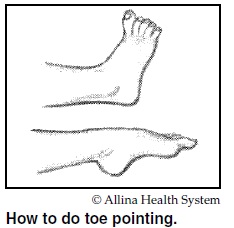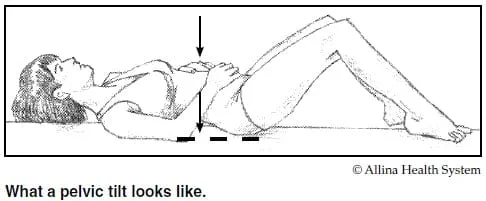
Exercise after birth
The first one to two weeks after birth
- Limit your activity to caring for yourself and your baby.
- If you had an exercise routine during pregnancy, ask your health care provider when you can begin again. You can start the gentle postpartum exercise routine described below the day after you give birth.
- If you have concerns about your postpartum weight loss, talk with your health care provider.
If you had a Cesarean birth:
- Try not to lift anything heavier than your baby.
- If you have other children who want to be held, sit down and have them climb into your lap rather than lifting them.
- Limit your trips up and down stairs. Take the stairs slowly.
Kegel exercises
You can start doing Kegel exercises the day after your baby is born. You may need to build up to the number of Kegels you were doing before your baby's birth. Start with regular Kegels and build up to doing super Kegels.
An early postpartum exercise routine
You can start this exercise routine the first day after your baby is born. Start with doing each exercise two times a day. Each day do one more repetition per set until you are doing 10 of each exercise two times a day.
Deep breathing with abdominal wall tightening
Position: Lying on your back or side with knees bent.
- Take a deep breath through your nose. Let your abdominal wall expand upward.
- With your lips slightly parted, blow air out through your mouth while tightening your abdominal wall.
- Keep blowing until you have emptied your lungs.
- Don't take too many deep breaths in a row or you might get dizzy.
Toe pointing

Position: Sitting or lying.
- Pull your toes toward you as far as you can.
- Point your foot downward.
- Repeat.
- Rest before continuing. If pointing your toes downward causes cramps: pull up your toes and relax.
Foot and ankle circles
Position: Sitting or lying.
- Make large, slow circles with each foot, first to the right, then to the left. This is an excellent exercise to improve the circulation in your legs.
Pelvic tilt
Position: Lying flat on your back with your knees bent and your fleet flat on the bed or floor.
- Tilt your pelvis back by flattening your lower back against the bed or floor.
- Tighten your abdominal muscles and your bottom.
This exercise strengthens your abdominal muscles and helps relieve backache.

From three to six weeks after birth
- Gradually return to normal activities. If something feels like it's too much to do, don't do it.
- Bend your knees whenever you lift anything, including older children, to help prevent injuring your back muscles.
- Avoid heavy lifting and vacuuming for at least six weeks.
- Wait at least six weeks before starting exercises like running, sit-ups or leg lifts unless your health care provider says you can start earlier.
- Before you start doing sit-ups or leg lifts, check to see if your abdominal muscles have separated:
- Lie on your back with your knees bent.
- Reach one arm toward your knees as you tighten your abdominal muscles and lift your head and shoulders.
- Put the fingers of your other hand just below your navel. You will feel your muscles tighten. If there is a separation between the two halves of your abdominal muscles that is three or more finger widths, you will need to do a special exercise to reduce this separation. This exercise is described next.
- Exercise to reduce abdominal muscle separation:
- Lie on your back with knees bent and 12 to 16 inches apart.
- Cross your hands over your abdomen so that you will be able to support your abdominal muscles.
- Breathe in deeply. As you exhale, raise your head toward your chest and gently pull the separated muscles toward each other.
- At the end of the exhale, lie back and relax.
- Do a set of these exercise two times a day.
- Start with two repetitions and add one repetition a day. Work up to a set of 10 repetitions twice a day. When the separation is less than two finger widths, you can start abdominal strengthening exercises, such as curl-ups and sit-ups.
Related resources